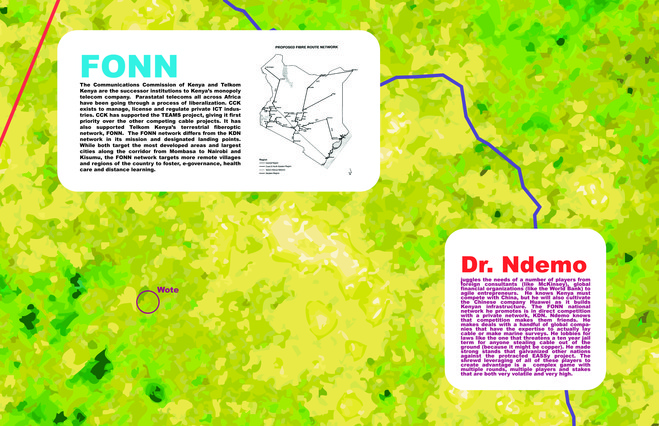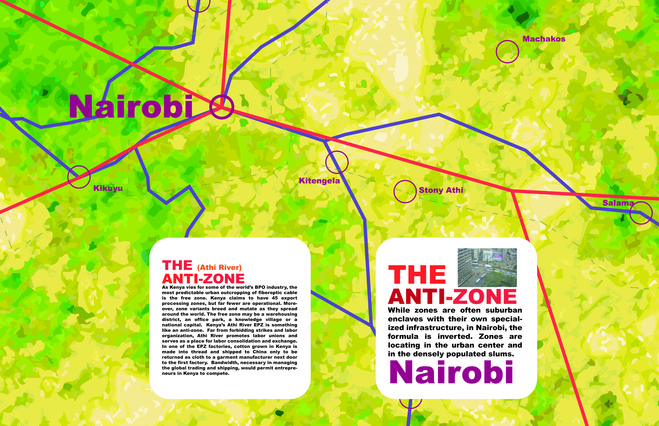-
-
-
Infrastructure space/
Keller Easterling:
Cable
-

-
The road between Nairobi and Mombasa is lined with, and virtually lit by, advertisements for the mobile phone companies that have entered the region—all promising new freedoms and economic opportunities. With their images of Masai tribesman in native dress phoning from a remote wilderness, the ads employ an essential trope of leap-frogging—the desire for a perfect collapse between technology and nature, tradition and modernity. The billboards express the enthusiasm of a world turned upside down in which not the developed but the developing world has their hands around a majority of the world’s cell phones.
Over the last 150 years, the ocean floor has been laid with thousands of miles of submarine cable of all types for telegraph, telephone, and fiber-optic infrastructure. In the nineteenth century, it took only thirty years for the British cable-laying companies to string the world with telegraph cable, and a little over a decade from the late 1980s to the late 1990s for most of the world to be connected to fiber-optic cable. Yet until recently, East Africa, one of the most populous areas of the world, had no fiber-optic submarine cable link and less than 1 percent of the world’s broadband capacity. A country like Kenya had to rely for its broadband on expensive satellite technology acquired in the 1970s that cost twenty to forty times its equivalent in the developed world. Before 2009, one Mbps (megabit per second) of bandwidth could cost as much as 7,500 US dollars per month against the world average of $200. The monthly cost of putting twenty-five agents on the phone was $17,000 instead of the $600–900 that it would cost in other developed countries.[1]
If telecommunication in East Africa has until recently been distinguished by deprivation, it is now often heralded for its explosive growth. In Kenya, the numbers have been skyrocketing. Between 2000 and 2008, the number of cell phone subscriptions increased over a hundredfold (from 127,404 in 2000 to 16,573,303 in 2008), and from 2008 to 2012 they nearly doubled again (30,731,745 in 2012).[2] After nearly fifteen years of planning, by the end of 2010 Kenya had gone from having no fiber-optic submarine cable to having three international cables and an expanding national fiber-optic system. The country needs broadband for mobile telephony,[3] but while many of its mobile phone users are now able to access the internet, Kenya is also still sorely lacking high-capacity premium fixed bandwidth for business and education.
The new power players of extrastatecraft are all present in Kenya—nations, kingdoms, global consultancies, and an array of international organizations and multinational enterprises. Broadband is now written into the policies of national governments and into the development goals of businesses as well as international organizations like the World Bank and the UN. The World Bank declares mobile telephony to be “the world’s largest distribution platform.”[4] A swarm of telecoms from all over the world compete for market share in underserved Africa. The expansion of new infrastructure capacities into densely populated, developing countries has also sponsored new business models and techniques of governance. Entrepreneurs identify multipliers and borrow crowd-sourcing techniques to penetrate the market with a flurry of new apps. Kenya is now being characterized as a potential leader in developing information and communication technologies—a “silicon savannah” for the entire continent of Africa.[5]
Kenya is a good place from which to consider the spatial variables of broadband infrastructure. Plenty of analysts on the ground are trying to predict the effects of broadband on what they call “Development 2.0.” Such analysis is undertaken in the languages of business, technology, informatics, and econometrics, but there is as yet little study of the interdependencies between broadband infrastructure and space. Urbanists frequently analyze the urban values and morphologies associated with physical infrastructures such as rail, highway, power and water utilities, yet the discipline is equally under-rehearsed in an analysis of the spatial dispositions attending broadband infrastructure.
The cell phone, like the new elevator, is a powerful multiplier that can be placed in a meaningful interplay with all of the other active forms in the broadband network to alterthe design of the city, village, road, school, and market. Designing new interdependencies between all of these spatial and technical variables could maximize access to the information carried in telecommunication networks as well as the information carried in the space of the city. Just as Kenya and other populous countries are offering the world new business models, they might also offer an advanced lesson in broadband urbanism.
[1] Regional Communications Infrastructure Program (RCIP) Videos, at www.worldbank.org/rcip; “Addressing Africa’s ‘Missing Link’,” at http://web.worldbank.org.
[2] ITU, World Telecommunications/ICT Indicators Database, 17th Edition, June 17, 2013, at www.itu.int; see also The Little Data Book on Information and Communication Technology (Washington, DC: World Bank, 2010). In 2000 there were 0.4 cell phone subscriptions per 100 people. By 2008 the number had risen to 42.1. See “Statistics Q1 2010–11,” at www.cck.go.ke.
[3] The World Bank defines broadband as requiring speeds of at least 256 kbps, while the ITU defines it in terms of capacity to carry voice, data, and video. See Mark D. J. Williams, “Advancing the Development of Backbone Network in Sub-Saharan Africa,” in World Bank, ed., Information and Communications for Development: Extending Reach and Increasing Impact (Washington, DC: World Bank, 2009).
[4] Mohsen Khalil, Philippe Dongier, and Christine Zhen Wei Qiang, “Overview,” in World Bank, ed., Information and Communications for Development.
[5] “Upwardly Mobile: Kenya’s Technology Start-up Scene is About to Take Off,” Economist, August 25, 2012.
-

-
In September 2000… There were some 740 million mobile cellular subscriptions and nearly 400 million internet users worldwide.
In 2010, there are more than 5 billion mobile cellular subscriptions and over 1.8 billion internet users according to ITU’s most recent data, with the majority located in the developing world.
-

It remains to be seen whether fiber will encourage familiar zones and enclave urbanism or whether, at a moment of technological convergence between mobile telephony and computers, the wireless broadband development will produce an entirely new forms of entrepreneurialism with entirely different urban patterns.
-

Cable, a 60×8 foot drawing was exhibited at Storefront for Art and Architecture in New York City in the fall of 2008.
-
-
-
-
-
©2012 The authors and contributors
-